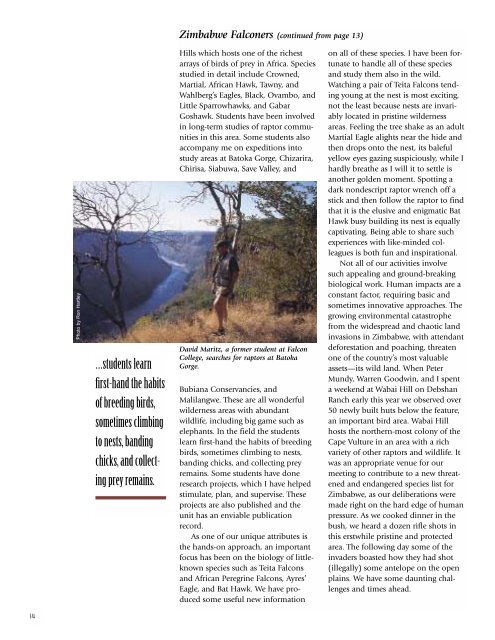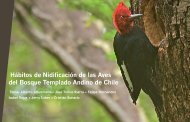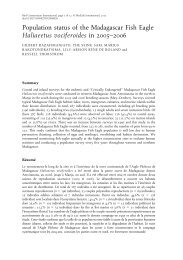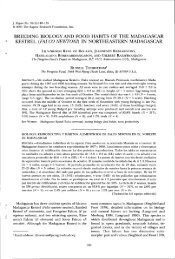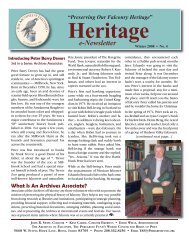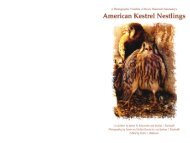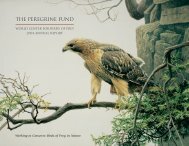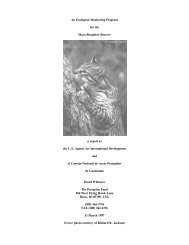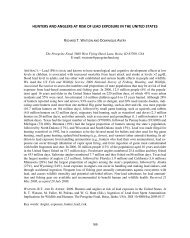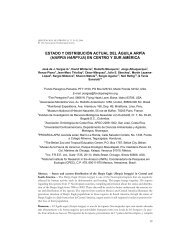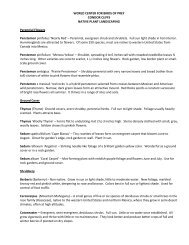2001 Newsletter - The Peregrine Fund
2001 Newsletter - The Peregrine Fund
2001 Newsletter - The Peregrine Fund
Create successful ePaper yourself
Turn your PDF publications into a flip-book with our unique Google optimized e-Paper software.
Zimbabwe Falconers (continued from page 13)<br />
Photo by Ron Hartley<br />
…students learn<br />
first-hand the habits<br />
of breeding birds,<br />
sometimes climbing<br />
to nests, banding<br />
chicks, and collecting<br />
prey remains.<br />
Hills which hosts one of the richest<br />
arrays of birds of prey in Africa. Species<br />
studied in detail include Crowned,<br />
Martial, African Hawk, Tawny, and<br />
Wahlberg’s Eagles, Black, Ovambo, and<br />
Little Sparrowhawks, and Gabar<br />
Goshawk. Students have been involved<br />
in long-term studies of raptor communities<br />
in this area. Some students also<br />
accompany me on expeditions into<br />
study areas at Batoka Gorge, Chizarira,<br />
Chirisa, Siabuwa, Save Valley, and<br />
David Maritz, a former student at Falcon<br />
College, searches for raptors at Batoka<br />
Gorge.<br />
Bubiana Conservancies, and<br />
Malilangwe. <strong>The</strong>se are all wonderful<br />
wilderness areas with abundant<br />
wildlife, including big game such as<br />
elephants. In the field the students<br />
learn first-hand the habits of breeding<br />
birds, sometimes climbing to nests,<br />
banding chicks, and collecting prey<br />
remains. Some students have done<br />
research projects, which I have helped<br />
stimulate, plan, and supervise. <strong>The</strong>se<br />
projects are also published and the<br />
unit has an enviable publication<br />
record.<br />
As one of our unique attributes is<br />
the hands-on approach, an important<br />
focus has been on the biology of littleknown<br />
species such as Teita Falcons<br />
and African <strong>Peregrine</strong> Falcons, Ayres’<br />
Eagle, and Bat Hawk. We have produced<br />
some useful new information<br />
on all of these species. I have been fortunate<br />
to handle all of these species<br />
and study them also in the wild.<br />
Watching a pair of Teita Falcons tending<br />
young at the nest is most exciting,<br />
not the least because nests are invariably<br />
located in pristine wilderness<br />
areas. Feeling the tree shake as an adult<br />
Martial Eagle alights near the hide and<br />
then drops onto the nest, its baleful<br />
yellow eyes gazing suspiciously, while I<br />
hardly breathe as I will it to settle is<br />
another golden moment. Spotting a<br />
dark nondescript raptor wrench off a<br />
stick and then follow the raptor to find<br />
that it is the elusive and enigmatic Bat<br />
Hawk busy building its nest is equally<br />
captivating. Being able to share such<br />
experiences with like-minded colleagues<br />
is both fun and inspirational.<br />
Not all of our activities involve<br />
such appealing and ground-breaking<br />
biological work. Human impacts are a<br />
constant factor, requiring basic and<br />
sometimes innovative approaches. <strong>The</strong><br />
growing environmental catastrophe<br />
from the widespread and chaotic land<br />
invasions in Zimbabwe, with attendant<br />
deforestation and poaching, threaten<br />
one of the country’s most valuable<br />
assets—its wild land. When Peter<br />
Mundy, Warren Goodwin, and I spent<br />
a weekend at Wabai Hill on Debshan<br />
Ranch early this year we observed over<br />
50 newly built huts below the feature,<br />
an important bird area. Wabai Hill<br />
hosts the northern-most colony of the<br />
Cape Vulture in an area with a rich<br />
variety of other raptors and wildlife. It<br />
was an appropriate venue for our<br />
meeting to contribute to a new threatened<br />
and endangered species list for<br />
Zimbabwe, as our deliberations were<br />
made right on the hard edge of human<br />
pressure. As we cooked dinner in the<br />
bush, we heard a dozen rifle shots in<br />
this erstwhile pristine and protected<br />
area. <strong>The</strong> following day some of the<br />
invaders boasted how they had shot<br />
(illegally) some antelope on the open<br />
plains. We have some daunting challenges<br />
and times ahead.<br />
14


